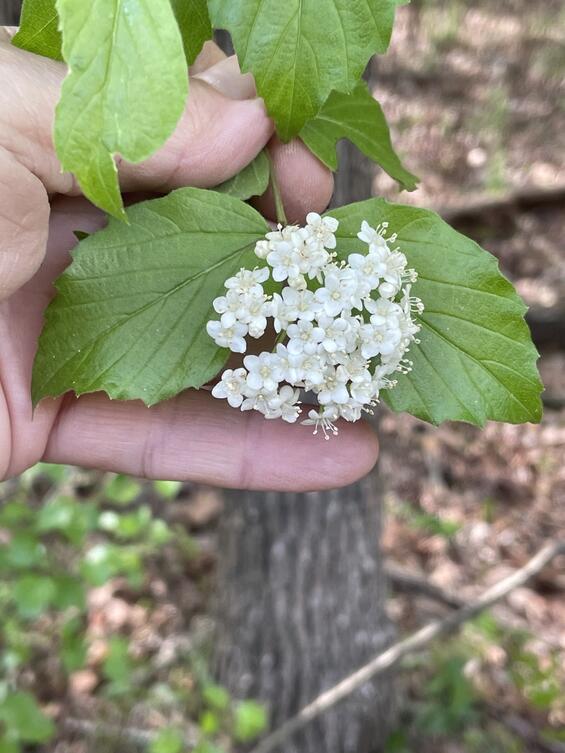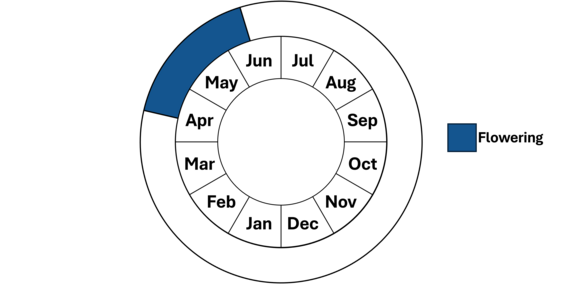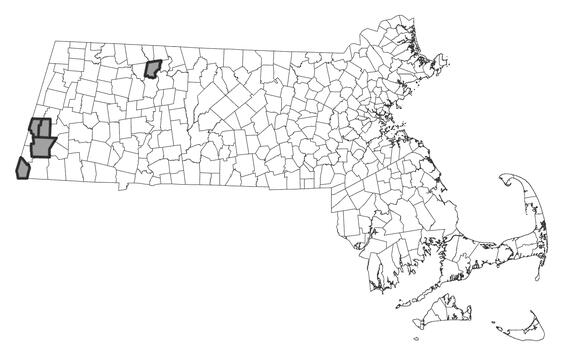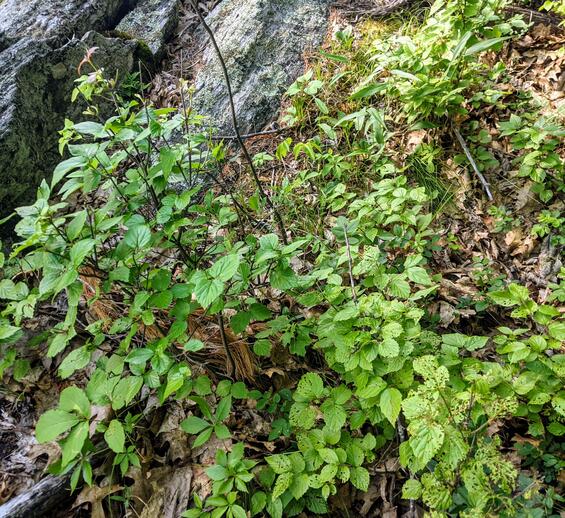- Scientific name: Viburnum rafinesqueanum
- Species of Greatest Conservation Need (MA State Wildlife Action Plan)
Endangered (MA Endangered Species Act)
Description

Image by Becky Dill, iNaturalist.
Downy arrow-wood (Viburnum rafinesqueanum) is a small to medium-sized shrub, generally less than 1.5 m (~ 5 feet) in height with egg-shaped opposite leaves. In late spring, it bears round-topped clusters of small white flowers that are followed by green flattened fruits that ripen to blue-black. Downy arrow-wood prefers dry open forests and in Massachusetts is often found on summits and ridges.
Downy arrow-wood has coarsely toothed ovate or narrowly ovate unlobed leaves. The petioles and lower leaf surfaces are covered with soft short hairs. Downy arrow-wood often has a pair of stipules at the base of each petiole.
Downy arrow-wood closely resembles all varieties of arrow-wood (southern arrow-wood (Viburnum dentatum var. venosum [formerly V. dentatum]) and northern arrow-wood (Viburnum dentatum var. lucidum [formerly V. recognitum]) in terms of stature, habit, flower shape and color, and fruit color. However, these two varieties are generally found in wetlands and are not frequent on dry hilltops. Downy arrow-wood can be distinguished from these by the pubescence on the lower leaf surfaces and the presence of stipules at the base of the short petioles.
Life cycle and behavior
Downy arrow-wood is a woody shrub species.

Population status

Image by Robert Wernerehl.
Downy arrow-wood is listed under the Massachusetts Endangered Species Act as Endangered. All listed species are protected from killing, collecting, possessing, or sale and from activities that would destroy habitat and thus directly or indirectly cause mortality or disrupt critical behaviors. MassWildlife's Natural Heritage & Endangered Species Program database has 5 records from 2 counties: Berkshire and Franklin. Three of those records are within the last 25-year period.
Distribution and abundance
Downy arrow-wood is found from Quebec and Manitoba southward through the Dakotas and most of the midwestern states to Alabama and Georgia. This species is considered vulnerable to critically imperiled in Quebec, New Hampshire, Connecticut, West Virginia, and Kentucky.

Distribution in Massachusetts. 1999-2024. Based on records in the Natural Heritage Database.
Habitat

Image by Robert Wernerehl.
In Massachusetts, downy arrow-wood is found on open rocky ridgelines, lightly wooded summits, and dry rocky slopes in both acidic and calcareous soils. Associated canopy species include red oak (Quercus rubra), chestnut oak (Q. montana), white oak (Q. alba), shagbark hickory (Carya ovata), hop hornbeam (Ostrya virginiana), and white ash (Fraxinus americanus). At one location Downy arrow-wood is found in association with yellow oak (Q. muehlenbergii), a Threatened species in the Commonwealth. Other associated shrubs may include gray dogwood (Cornus racemosa) and pasture rose (Rosa caroliniana). Vines may include Virginia creeper (Parthenocissus quinquefolia) and poison ivy (Toxicodendron radicans). Common associated herbaceous species include Pennsylvania sedge (Carex pensylvanica), bottlebrush grass (Elymus hystrix), field chickweed (Cerastium arvense), columbine (Aquilegia canadensis), wild geranium (Geranium maculatum), small-flowered bittercress (Cardamine parviflora), lyre-shaped rock-cress (Arabidopsis lyrata; endangered), ebony-spleenwort (Asplenium platyneuron), and marginal fern (Dryopteris marginalis).
Healthy habitats are vital for supporting native wildlife and plants. Explore habitats and learn about conservation and restoration in Massachusetts.
Threats
Herbivory is a threat to downy arrow-wood. In two populations, browsing by white-tailed deer has been noted as severe. Feeding by the non-native viburnum leaf beetle (Pyrrhalta viburni) could be detrimental. Other threats include trampling by recreational activities and competition with invasive species.
Conservation
Sites should be monitored for deer browse and defoliation by the viburnum leaf beetle. Some populations may be assisted by erecting a deer exclosure fence. Sensitive open rocky woods and summits should be protected from recreational overuse. Known locations should be buffered from activities that would cause direct impacts to populations or alter light or moisture conditions. Invasion by non-native plants such as buckthorn (Rhamnus cathartica) has been identified at one site. Methods to address these invasive plants or herbivory should be incorporated in a plan developed in consultation with MassWildlife's Natural Heritage and Endangered Species Program. All active management of rare plant populations (including invasive species removal) is subject to review under Massachusetts's Endangered Species Act and should be planned in close consultation with the Natural Heritage and Endangered Species Program.
References
Massachusetts Department of Agricultural Resources. 2008. Pest alert: Viburnum leaf beetle. Massachusetts Introduced Pest Outreach Project, Boston, MA. Available via http://www.massnrc.org/PESTS/pestFAQsheets/viburnumleaf.html, Accessed May 3, 2010.
Rhoads, A. F. and T. A. Block. 2000. The Plants of Pennsylvania: an illustrated manual. University of Pennsylvania Press, Philadelphia, PA.
Contact
| Date published: | May 7, 2025 |
|---|